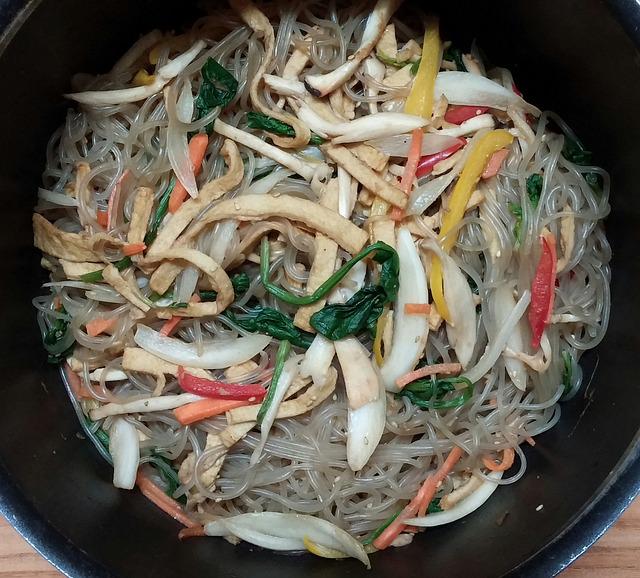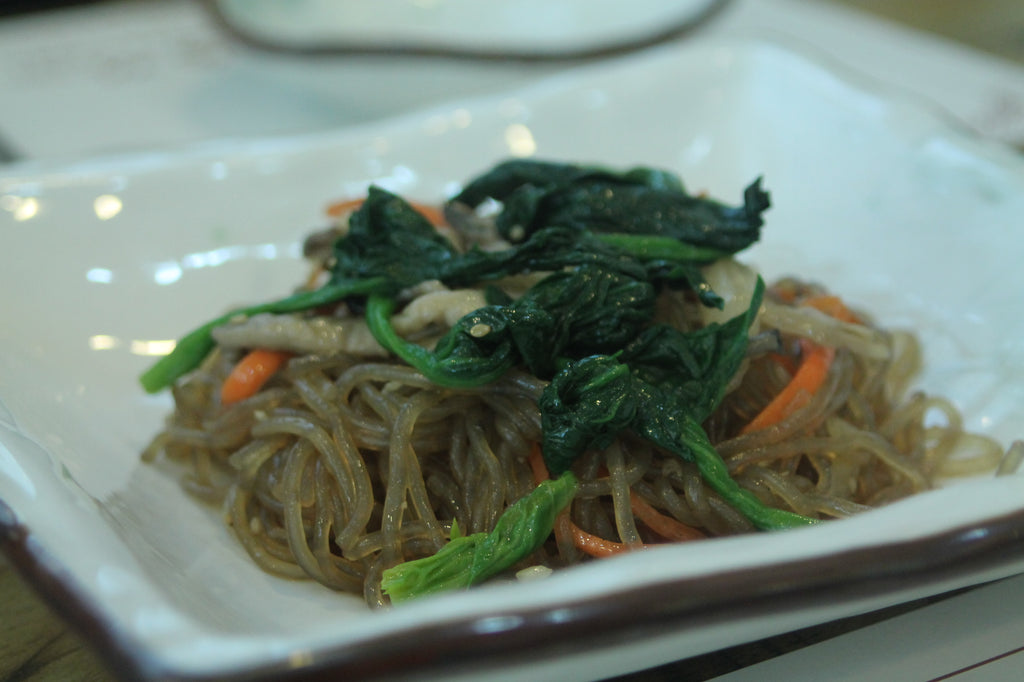Japchae (잡채; 雜菜) is one of the most beloved Korean dishes. This savory and sweet noodle dish can be served on its own or as a side dish accompanying an entree. Over the past decade, Alphabet, Inc, estimates that “Korean bbq” has gained over 1000% in search volume. This rise in popularity has brought japchae to the forefront of Korean cuisine in the United States.
Japchae Basics
At its core, Japchae is composed of three key ingredients: noodles, vegetables, and meat (typically). As we will see, the specific choices of each ingredient can drastically affect the dish, allowing individuals to personalize the type of japchae they’d like to have.
Japchae is often served as a celebratory dish. This doesn’t mean one can’t make japchae after work on a typical Wednesday, but traditionally it is served on birthdays, holidays, or any occasion worth celebrating.

Japchae History
Japchae (pronounced “chaap Chay” with the stress on the second syllable) is a combination of two Korean syllables, “jap”, meaning mixed, and “chae,” meaning vegetables; it is a relatively old Korean dish. As the story goes, japchae was first served sometime in the 17th century by Yi Chung for a banquet at the palace of King Gwanghaegun, the 15th ruler of the Joseon Dynasty of Korea. Legend says that the king was so enthralled by the dish that he promoted Chung to a high-ranking job and japchae earned its place as a part of Korean royal court cuisine.
Like many other formally royal dishes, japchae began to gain popularity as a food for non-royals. It is somewhat different than the first iteration 400 years ago, but at its core, it’s the same, delicious dish.
Japchae Preparation
At the heart of a good japchae is a core of well-selected base components. Let’s dive into what makes up this wonderful Korean dish.
Noodles
The base of most japchae is noodles of some kind. In modern cooking, these noodles can take one of many different forms, but all generally fall within the same family. Commonly referred to as “glass noodles,” dangmyeon is made from a simple combination of starch and water.
Interestingly, “cellophane” noodles can be found in many parts of East Asia. The original noodle is thought to have originated in China, and it has since spread to many other countries including Korea, Taiwan, and India. Depending on the region, glass noodles will utilize different types of starch. In China, they are often made with mung bean starch or sweet potato starch. Korean glass noodles are usually made with sweet potato starch, but they are often slightly thicker than their Chinese counterparts.
Typically, cellophane noodles are cooked and served in the dish. In some regions and localities, it is more common for the noodles to be stir fried as well.
Vegetables
A litany of different veggies may be used. As these are often the main component of japchae, the type and amount of each vegetable is an important characteristic of any given dish. Common additions include carrots, spinach, red bell pepper, onion, scallions, egg, and mushrooms. When mushrooms are included, there are several different types that are commonly used, including oyster, shiitake, and wood ear mushrooms. Each of these ingredients is then stir fried and added to the noodle mixture.
Protein
Unlike some other Korean dishes, such as bulgogi, the exact cut or meat chosen is not the defining characteristic of the dish. Both pork and beef are common additions. The meat can be prepared in a variety of ways, but it is most commonly stir-fried.
Presentation
Once the noodles, vegetables, and meat are all prepared, they are tossed together to make the final dish. Japchae is typically seasoned with a mixture of soy sauce, sesame oil, garlic, and a sweetener, such as brown sugar. Depending on the preference (and spice tolerance!) of the chef, Korean japchae may have garnishes, such as sesame seeds and chili threads.

Japchae Recipe
Let’s get cooking! Japchae is one of our favorite Korean noodle dishes. Here is a traditional japchae recipe that can be modified and altered in any way that a chef sees fit. Follow this recipe to brighten up your next party, birthday, or holiday! Japchae may be served as either a main dish or a side dish, so plan that amount accordingly. Total time is about 45 minutes, excluding marinating time. Prep time is roughly 25 minutes, cook time is roughly 20 minutes. This recipe will serve about four people. Nutritional information, including kcal, cholesterol, and carbohydrates will vary with vegetable and protein choices.
Ingredients
-
4 ounces meat, cut into thin strips. If using beef, we suggest sirloin or skirt steak. If using pork, try pork shoulder.
-
2 large, dried shiitake mushrooms, cut into strips. Soak the mushrooms in water for about 2 hours beforehand.
-
2 garlic cloves, minced
-
4 ounces spinach
-
5 ounces dangmyeon
-
2 to 3 scallions (green onions), cut crosswise into 2 inch long pieces
-
1 medium white onion, thinly sliced
-
4 to 5 white mushrooms, thinly sliced
-
1 medium carrot (¾ cup), matchsticked
-
1 tablespoons sugar
-
soy sauce
-
toasted sesame oil
-
1 tablespoon The Happy Ms. Jungeun Toasted Sesame Seeds
-
black pepper
-
salt
-
vegetable oil
Directions
- If using dried mushrooms, make sure they have been soaking for ~2 hours prior to cooking. If this is not possible, fresh mushrooms will work.
- Take strips of meat and mushroom, combine in a large mixing bowl with 1 clove garlic, a large pinch of sugar, ½ teaspoon black pepper, 2 teaspoons soy sauce, and 2 teaspoons sesame oil. Refrigerate.
- Bring a large pot of water to boil. Blanch spinach for roughly 45 seconds, remove from water and douse with cold water.
- Dry spinach and cut into strips. Combine in bowl with 1 teaspoon each of soy sauce and sesame oil.
- In same pot, place noodles into boiling water, stirring for one minute. Cover and cook for another ~6 minutes, checking every 2 minutes. Remove from water when noodles are soft, but chewy. Drain noodles.
- Strain noodles and add 2 teaspoons each of soy sauce and toasted sesame oil. Mix well and add a large pinch of sugar.
- Heat skillet or wok (any non-stick pan) over medium-high heat, add vegetable oil. Add onions and scallions. Saute for ~2 minutes. Remove from heat, add to noodles.
- Repeat above process with white mushrooms, stir frying for another ~2 minutes. Transfer to noodle bowl.
- Repeat with carrots, stir frying for ~90 seconds. Add to noodle bowl.
- Repeat with marinated beef and mushroom mixture. Depending on the type and thickness of meat, stir fry for 5-10 minutes. Ensure meat is cooked before removing and adding to noodles.
- Mix entire bowl together with a few cloves of chopped garlic as well as soy sauce, toasted sesame oil, black pepper, and a pinch of salt, to taste.
- Serve immediately along with side dishes such as kimchi.
For another great recipe, check out this version from our kitchen!
Keywords: South Korea, Korean food, korean recipes, japchae, sesame oil, noodles


